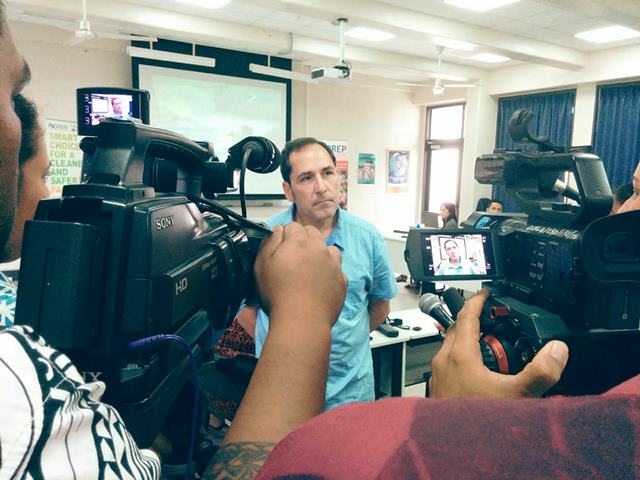
Climate Change Resilience
Finding the 'right' angle for your climate change story was a lot easier for members of Samoa's media after the "Strengthening Environmental Journalism to Build Community Resilience to Climate Change Workshop" held at SPREP in March.
The Pacific GeoJournalism Project is a Pacific American Climate-Fund Project funded by USAID and implemented by the Internews Earth Journalism Network. SPREP partnered with the project in Samoa to help carry out the training which was open to Samoa media and journalism students of the National University of Samoa.
The two-day training facilitated by the Internews Earth Journalism Network covered climate science, climate from the Pacific, Samoa's policy on climate change and their place in the UNFCCC process, including how to develop different angles on climate stories - which proved to be the most popular subject.
 James Fahn interviewed by Samoa media - image courtesy of Lagipoiva Cherelle Jackson
James Fahn interviewed by Samoa media - image courtesy of Lagipoiva Cherelle Jackson
"Climate change is the greatest story of our time," said James Fahn, from Earth Journalism Network. "The Pacific is most likely to feel the impacts of climate change, but we don't have enough Pacific journalists telling those stories, so our goal is to encourage you to tell the stories of how climate change is impacting your countries and your people" he added.
A field trip to Palolo Deep Marine Reserve, allowed participants to see for themselves the impacts of climate change on a coastal community and the Marine reserve.
The next stage of this project is to fund opportunities to develop stories on climate change and, fellowships to cover environment conference which the Earth Journalism Network hopes will inspire more Pacific writers to apply for these.
The Pacific GeoJournalism Project is a two year activity that spans Samoa, Fiji and Vanuatu with the training in Samoa held from 17 - 18 March, 2016.
For more information please contact [email protected]
The Pacific GeoJournalism Project is a Pacific American Climate-Fund Project funded by USAID and implemented by the Internews Earth Journalism Network. SPREP partnered with the project in Samoa to help carry out the training which was open to Samoa media and journalism students of the National University of Samoa.
The two-day training facilitated by the Internews Earth Journalism Network covered climate science, climate from the Pacific, Samoa's policy on climate change and their place in the UNFCCC process, including how to develop different angles on climate stories - which proved to be the most popular subject.
 James Fahn interviewed by Samoa media - image courtesy of Lagipoiva Cherelle Jackson
James Fahn interviewed by Samoa media - image courtesy of Lagipoiva Cherelle JacksonA field trip to Palolo Deep Marine Reserve, allowed participants to see for themselves the impacts of climate change on a coastal community and the Marine reserve.
The next stage of this project is to fund opportunities to develop stories on climate change and, fellowships to cover environment conference which the Earth Journalism Network hopes will inspire more Pacific writers to apply for these.
The Pacific GeoJournalism Project is a two year activity that spans Samoa, Fiji and Vanuatu with the training in Samoa held from 17 - 18 March, 2016.
For more information please contact [email protected]